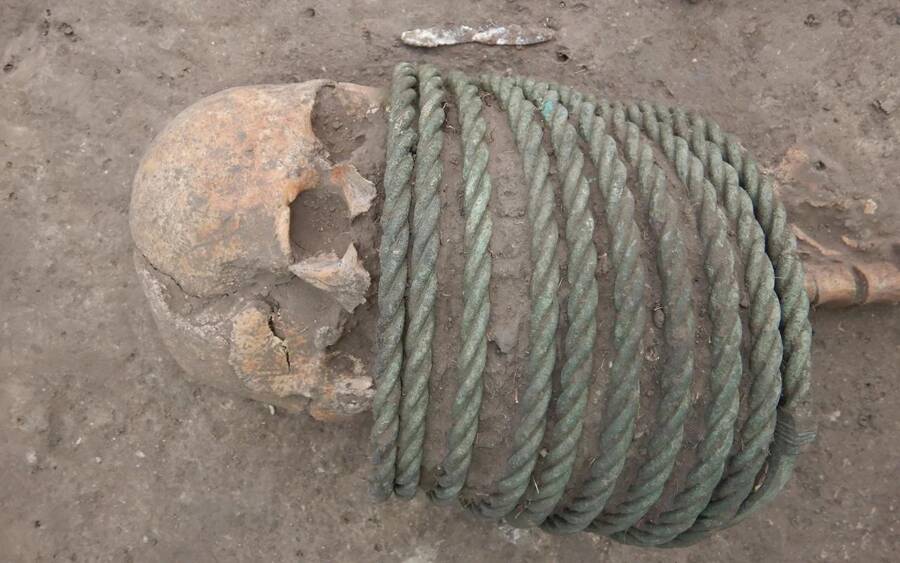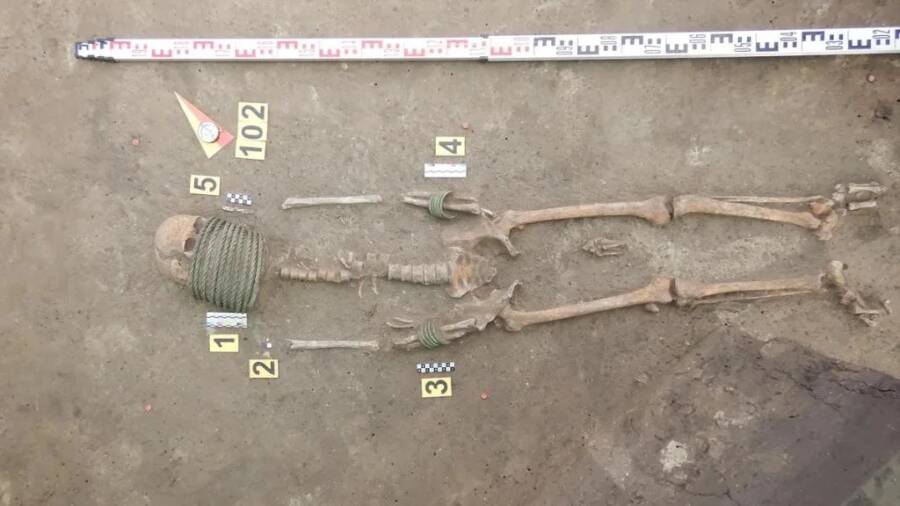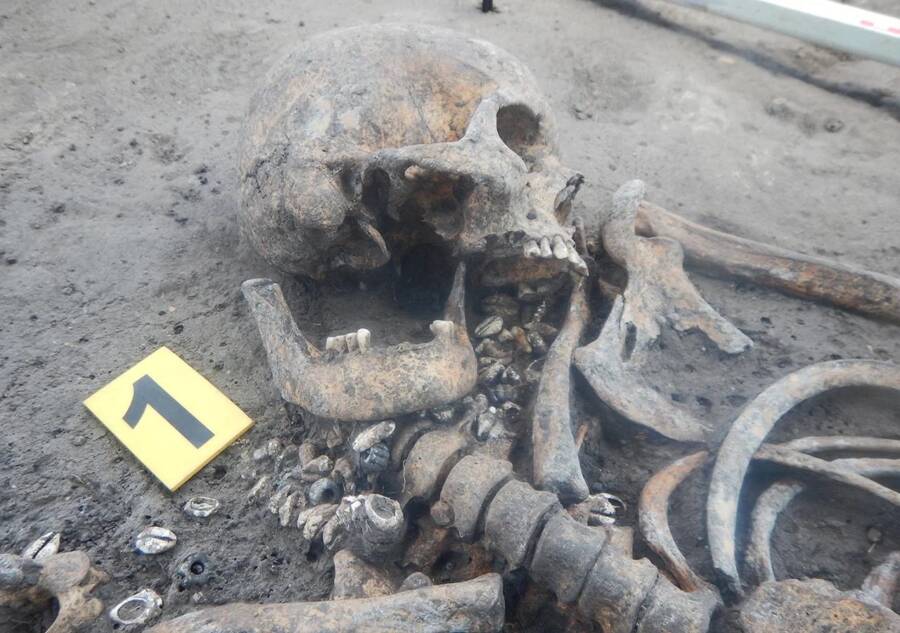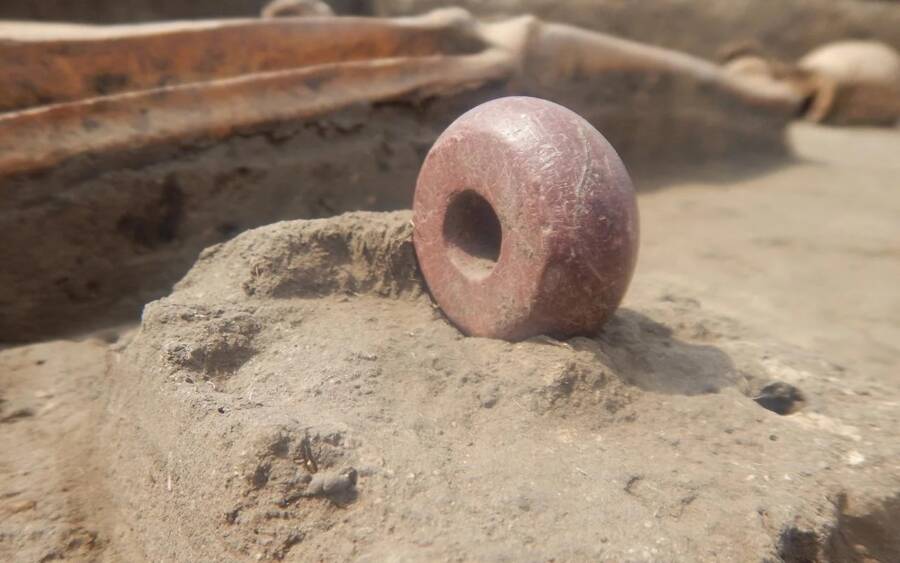
Skeletons With Rings Around Their Necks Uncovered At A 1,000-Year-Old Cemetery In Ukraine
The burials at the cemetery near the western Ukrainian village of Ostriv displayed a puzzling mix of Kyivan and Baltic customs.
By: Austin Harvey | All That Interesting
Archaeologists in Ukraine have unearthed a 1,000-year-old cemetery and a number of skeletons buried with rings around their necks and buckets at their feet.
The cemetery was discovered just south of Kyiv and dates back to the 11th century, a pivotal time in Ukraine when many people had begun converting to Christianity. In total, there were 107 graves found at the site, with most of the remains in wooden coffins.
Skeletons of both men and women were found in the cemetery, some of whom were buried with an assortment of objects, including weapons and jewellery. Some of the men were interred with axes, spearheads, and swords. Meanwhile, several of the women were buried with elaborate rings around their necks. Study co-author Vyacheslav Baranov told Live Science that these bronze rings “were apparently a kind of social marker.”
It is not entirely clear why some people buried at the site had wooden buckets placed at their feet, but experts believe it may have been part of a funerary ritual.

“Other elements, such as buckets from two Ostriv male graves, are also found at 11th century Prussian cremation and Pomeranian and Masovian inhumation cemeteries of military elites,” Baranov and project co-lead Vsevolod Ivakin wrote in their study, which was published in the journal Medieval Archaeology.
Curiously, the arrangement of the graves was atypical for burials in the region. Rather than facing north, as was usual for the area, these graves faced to the south and west.
Scientists: Geological Evidence Shows The Great Sphinx Is 800,000 Years Old
Baranov and Ivakin’s findings were presented in early January at the Archaeological Institute of America’s annual meeting in Chicago.
Excavations at the cemetery began in 2017 and continued through 2022.

In addition to the 107 graves, the archaeologists also uncovered a stone altar. There were various offerings left nearby, including bracelets, beads, and food such as chicken bones and eggshells. This altar could have been used for either Pagan or Christian rituals — or possibly both, as the people of Ukraine were making the transition from Paganism to Christianity around the time the cemetery was in use.
Researchers also noted that the burials at this site were reminiscent of graves found in Baltic regions. Experts theorized that some of the people interred in the cemetery may have travelled to Ukraine to serve under powerful military leaders such as Volodymyr the Great.

However, the burials were not entirely consistent with Western Baltic tradition. Whereas many Baltic people practiced cremation, no evidence of this was found at the cemetery site in Ostriv. Perhaps, researchers suggested, this had to do with constraints imposed upon funerary practices by Christian leaders like Volodymyr the Great and Yaroslav the Wise.
Volodymyr the Great’s rule did extend into some Baltic territories, and his own conversion to Christianity around 987 C.E. likely held great influence over his domain.
This excavation was halted due to the ongoing Russian invasion of Ukraine, which has forced various archaeological studies to be put on pause. Thankfully, the project still has a wealth of information to offer about the distant past.
* * *
NEXT UP!
700,000-Year-Old Skull Found In Greece Completely Shatters ‘Out of Africa Theory’
In 1959, a human skull, that has been dated back 700,000 years and is now known as the “Petralona Man” or the “Archanthropus of Petralona,” was unearthed. Since that time, researchers have been pondering the question of where exactly this skull came from, which has sparked a significant amount of discussion.
The skull, which was found lodged in the wall of a cave in Petralona, located close to Chalkidiki in Northern Greece, is considered to be the oldest human “Europeoid” (showing European traits). A shepherd accidentally discovered the cave, which was filled with stalactites and stalagmites. In the following years, researchers also unearthed a vast quantity of fossils, which included pre-human species, animal hair, petrified wood, stone and bone tools, and other artefacts.
The President of the Petralona Community gave the skull to the University of Thessaloniki in Greece. The agreement stated that once the investigation was completed, a museum displaying the findings from the Petralona cave would be opened, and the skull would be returned to be displayed in the museum. However, this promise was never fulfilled.
* * *
READ MORE: Graham Hancock: Ancient Civilization Wiped Out By Massive Comet 22,000 Years Ago
Ancient Origins: These 4 Ancient Civilizations Existed On Earth Long Before Human Race
Telegram: Stay connected and get the latest updates by following us on Telegram!
We’d love to hear from you! If you have a comment about this article or if you have a tip for a future Collective Spark Story please let us know below in the comment section.
